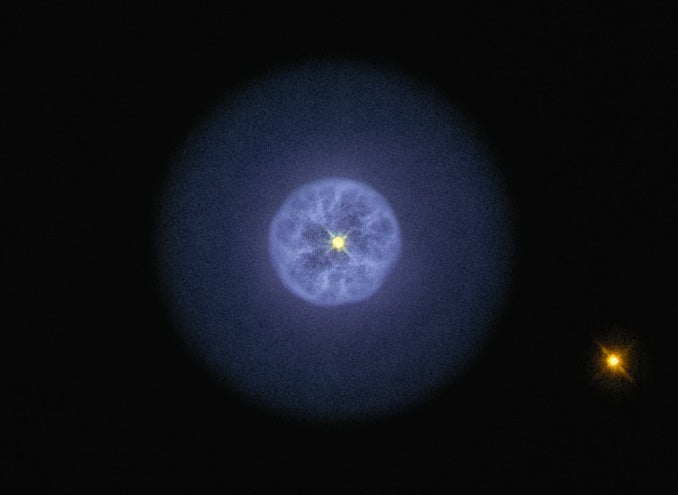
You’ll find the Lemon Slice Nebula (IC 3568) in the far northern reaches of Camelopardalis the Giraffe. The name comes from a Hubble Space Telescope false-color image showing a yellow disk with a “fibrous” radial pattern that resembles a lemon in cross-section. Visually, the color is decidedly nondescript; if anything, it is a more typical bluish from ionized gases like oxygen and nitrogen.
IC 3568 has the distinction of being the northernmost planetary nebula at 82.5° in declination. It lies nearly midway between Polaris and Kochab, forming an obtuse triangle from its position outside the border of Ursa Minor. At magnitude 10.6, it’s bright enough for a small telescope. The Lemon Slice has two shells. The brighter inner shell is only 6″ in diameter, roughly the apparent size of Uranus. The outer shell is 18″ across and is best seen in larger telescopes because it has a lower surface brightness. The central star is easily seen at magnitude 12.3.
Planetary nebulae with multiple shells are typical, as the central star sheds gas periodically as it evolves. The outer shell is often too faint to see visually or, as in this case, requires a large telescope.
The Lemon Slice Nebula lies about 4,500 light-years away, with a diameter of 0.4 light-year. That’s 2.4 trillion miles (3.8 trillion kilometers), or more than 25,000 times the distance from Earth to the Sun! It’s small compared to other planetary nebulae, but huge compared to the solar system. When our Sun becomes a planetary nebula in 5 billion years, it will expand into the Oort Cloud, the sphere of debris far beyond the orbit of Pluto.









